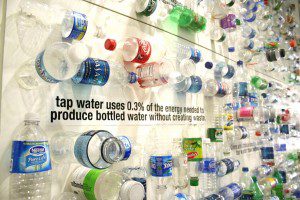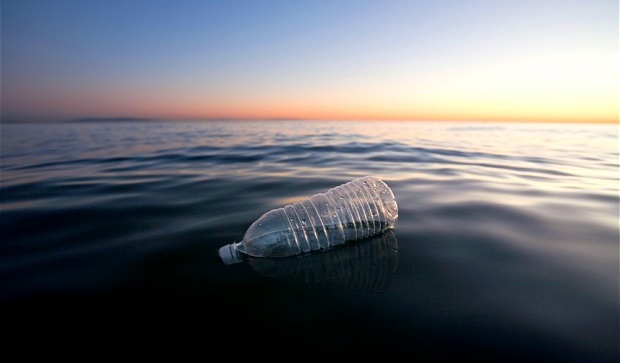By Joey Espinoza
Guest Writer for Wake Up World
Bottled water is one of the most convenient beverages. These days it’s right up there with Coke and Pepsi in terms of availability and abundance in the marketplace. Of course when these large corporations are also 50% of the market share for bottled water, you would expect to see this sort of thing.
It’s great that more and more Americans are drinking bottled water because perhaps that is a sign of them drinking less soda; which is just a sugary phosphoric acid drink. Of course we would love people to drink water over soda, however bottled water still has many disadvantages to be aware of.
To be specific, the real disadvantages are with plastic bottled water. Plastic is an issue not only because it causes chemical changes to your drinking water but it also has an massive effect on our environment (darn humans and our quest for convenience at all costs!)
There are 50 billion water bottles consumed globally each year. Around 30 billion of them are consumed in the US which shows that Americans are about 60% responsible for the problem while only being 4% of the global population. That’s 1,500 water bottles consumed every second in the U.S.
[pro_ad_display_adzone id=”110028″]
That’s a lot of bottles!
9.1 billion gallons or 29.1 gallons per person per year to be exact. That is based on 2011 statistics.
The real irony to all of this is the fact that we all have access to very inexpensive water at home with our tap water. Of course these days tap water is full of toxins such as fluoride and chlorine, however with home purification systems readily available, it’s quite easy to ensure a clean, fresh supply of drinking water without the plastic waste.
Let’s get deeper into the disadvantages of bottled water, and in particular the huge role that plastic plays.
What is involved in manufacturing plastic water bottles?
We use 17 million barrels of oil each year to produce all of those plastic water bottles. To put that into perspective, that much oil could keep a million cars fueled for an entire year!
According to the Earth Policy Institute, the energy used to pump, process, transport and refrigerate all of that bottled water accounts for over 50 million barrels of oil each year. 50 million barrels of oil for something that is a completely unneeded and available in our homes.
Next time you are in the grocery store or supermarket, grab a plastic water bottle and envision it filled with 25% oil – because that is how much oil it takes just to manufacture it!
Aside from the environmental impact of the plastic waste, there are further impacts caused by the delivery of all this plastic water. We are using 40,000 18-wheeler trucks just to deliver this plastic water every week!
How is the plastic impacting our environment?
Of course, water bottles are made of completely recyclable polyethylene terephthalate (PET) plastics, but PETs don’t biodegrade, they photodegrade, which essentially means they do not degrade by biological processes but light processes. Of course, plastic piled in a landfill will rarely see any light. However in the ocean, which is where tons of grocery bags, soda bottles and six-pack rings end up, plastic is in as much light as water.
In 2009, researchers from Nihon University in Chiba, Japan, found that plastic in warm ocean water can degrade in as little as a year. Sounds pretty good right? Sure, until you find out that those small bits of plastic are toxic chemicals like bisphenol A (BPA) and PS oligomer. These chemicals end up in the guts of animals or wash up on the shore, where humans will come into direct contact with the toxins.
According to the Ocean Conservatory, every square mile of the ocean has over 46,000 pieces of plastic floating in it.
 But we recycle, so it’s all good – right?
But we recycle, so it’s all good – right?
Eighty percent of the water bottles bought in the United States don’t get recycled. Instead they end up in landfills which is the absolute worst place for them to be. So for every 10 bottles purchased only 2 of them will be recycled.
In America the recycle rate for PET bottles is only 23 percent, which indicates that we throw 38 billion plastic water bottles into landfills each and every year.
Are you beginning to see the disadvantages of bottled water? Let’s dig some more…
Isn’t bottled water safer and cleaner?
Not true. In fact, the majority of evidence shows that it’s worse for your health than purified tap water. The issue with plastic is that it leaches toxins into the water it is holding, a fact that has been linked to different types of cancer. Dangerous hormone-disrupting phthalates leach into the bottled water we drink within weeks of storage (from the time of production), and much faster if the bottled water is left in the sun (like that one sitting in your car right now).
Of course, tap water is far from perfect because the purity has many variables depending on where you live. Although the same could be said for plastic bottled water. The National Resources Defense Council conducted a study on plastic bottled water and determined that 22 percent of the water tested contained contaminant levels that exceeded local state health limits.
Interestingly, San Francisco draws its public drinking water supply from nearby Yosemite National Park, it is so pure they don’t even require it to be filtered.
If you are interested in knowing the quality of your local water, you can check out water quality reports here:
- EPA website
- American Water Works Association
- Association of Metropolitan Water Agencies
- Association of State Drinking Water Administrators
Outside the United States, just do a simple Google search using the terms “water quality report [your city]” and you will typically find the results you’re looking for.
Bottled water is expensive!
The average cost of one bottle of water $1.45 US. So let’s put this in perspective….
If tap water cost the same per gallon as the cheapest bottled water, the total cost of monthly household water bills – if we were paying these crazy prices – would be $9,000 per month!
Purified tap water is best
With a home purification system, and glass bottles for storage, it’s easy to ensure a fresh, non-toxic supply of drinking water, without the plastic waste.
I recommend the Drops of Balance water purification system, a mineral solution you can simply add to the tap water from your home. It removes toxins like fluoride, mercury, lead, arsenic and chlorine, and also adds important ionic sulfated minerals – which empty water can actually pull from your body.
If you are interested in trying Drops of Balance for yourself, they have offered Wake Up World readers a special introductory price for the 16oz size bottle. Just visit the Drops Of Balance website and use the coupon code: TRY16 with your order.
[pro_ad_display_adzone id=”110027″]








